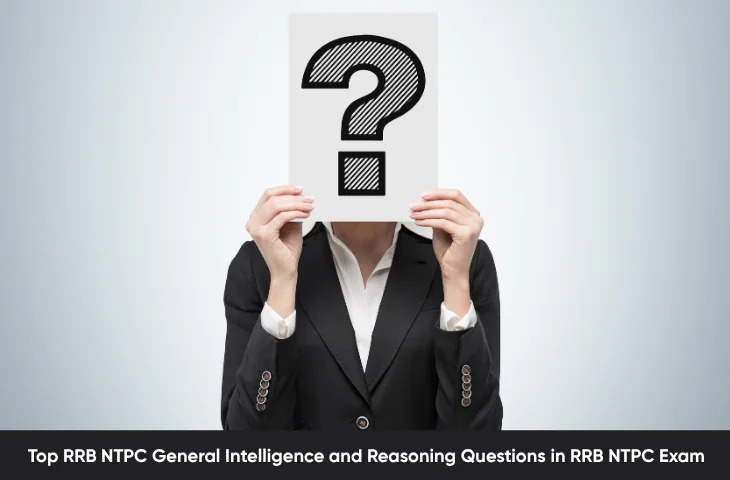RRB NTPC General Intelligence and Reasoning Questions: The General Intelligence and Reasoning (GIR) section is one of the most scoring and crucial parts of the RRB NTPC exam. It tests a candidate’s analytical thinking, logical reasoning, problem-solving ability, and decision-making skills. This section is common for both CBT-1 and CBT-2, with questions often repeated or patterned in previous exams. Therefore, focusing on frequently asked questions can significantly boost your chances of success.
Key Topics in General Intelligence and Reasoning
The RRB NTPC General Intelligence and Reasoning Question broadly includes topics like:
- Analogies – Finding relationships between two items.
- Coding–Decoding–Deciphering coded messages.
- Series (Number & Alphabet) – Identifying patterns in sequences.
- Blood Relations – Understanding family relationships.
- Direction Sense – Determining positions based on movements.
- Seating Arrangements & Puzzles – Logical placement of people or items.
- Syllogisms – Deductive reasoning.
- Statement & Assumptions / Statement & Conclusions – Analytical judgment.
Why These Questions are Important?
The General Intelligence and Reasoning Questions in the RRB NTPC Syllabus are very important as it is a high scoring section. Some of the reasons are given below:
- High Repeatability: Many questions in RRB exams are repeated with minor variations.
- Scoring Potential: Reasoning questions require less calculation and can be solved quickly with proper strategies.
- Foundation for Other Sections: Logical thinking enhances performance in quantitative reasoning and aptitude.
Most Repeated General Intelligence & Reasoning Questions
Below is a table of the most common question types with examples, answers, and brief explanations. This is compiled from previous years’ RRB NTPC exams.
| Q.No | Question Type | Question | Options | Answer | Explanation |
| 1 | Number Series | Find the next number: 2, 6, 12, 20, 30 | a) 36 b) 42 c) 44 d) 40 | b) 42 | Differences: 4,6,8,10 → next difference =12 → 30+12=42 |
| 2 | Alphabet Series | Find the next letters: A, C, F, J, O | a) S b) T c) R d) Q | b) T | Positions: 1,3,6,10,15 → +2,+3,+4,+5 → next=21 → T |
| 3 | Coding-Decoding | If CAT → 3120, DOG → ? | a) 4157 b) 4715 c) 4716 d) 4516 | c) 4716 | C=3, A=1, T=20 → D=4, O=15, G=7 → 4716 |
| 4 | Blood Relations | A is father of B. B is mother of C. How is A related to C? | a) Grandfather b) Uncle c) Brother d) Father | a) Grandfather | A is parent of B (mother of C) → Grandfather |
| 5 | Direction Sense | A walks 5m north, then 5m east. Direction from start? | a) NE b) NW c) SE d) SW | a) NE | Movement forms a right triangle → final direction = North-East |
| 6 | Seating Arrangement | 5 persons A, B, C, D, E in a row. A left of B, right of C. D right of E. Who is in the middle? | a) A b) B c) C d) D | a) A | Arrangement: C, A, B, E, D → middle = A |
| 7 | Puzzles | 3 boys and 2 girls in a row. A left of B, B right of C. Girls not at ends. Who sits 2nd? | a) B b) A c) Girl d) C | b) A | Placement: C, A, B, Girl1, Girl2 → 2nd = A |
| 8 | Syllogism | Statements: All cats are animals. All animals are living beings. Conclusion? | a) All cats are living beings b) All living beings are cats c) No cat is living being d) Cannot say | a) All cats are living beings | Deductive reasoning: Cats → Animals → Living beings |
| 9 | Statement & Conclusion | Statement: All books are pens. Conclusion: Some pens are books. | a) Yes b) No c) Can’t say d) None | a) Yes | Direct conclusion from statement: Some pens are books is true |
| 10 | Analogy | Hand : Glove :: Foot : ? | a) Sock b) Shoe c) Sandal d) Mitten | b) Shoe | Just as hand is covered by glove, foot is covered by shoe |
Download RRB NTPC General Intelligence and Reasoning Questions Free PDF
Additional Tips for RRB NTPC GIR Section
Given below are some additional tips for scoring well in the RRB NTPC General Intelligence and Reasoning section:
- Practice Mock Tests Regularly: Simulates exam environment and improves speed.
- Focus on Patterns: Many number/alphabet series and coding-decoding questions follow a fixed formula.
- Time Management: Allocate ~1–2 minutes per question for easy questions; puzzles and seating arrangements may need 3–4 minutes.
- Use Elimination Technique: For analogy, syllogism, and statement-conclusion questions, eliminate options logically.
- Keep Notes: Maintain a small notebook for formulas, tricks, and frequently repeated series.
Common Tricks for RRB NTPC General Intelligence and Reasoning Questions
The table below shows the common tricks for solving RRB NTPC General Intelligence and Reasoning Questions:
| Topic | Shortcut |
| Number Series | Check differences, ratios, or squares/cubes patterns |
| Alphabet Series | Convert letters to numerical positions in the alphabet |
| Coding-Decoding | Identify consistent patterns: addition/subtraction, reverse order, multiplication |
| Direction Sense | Draw quick diagrams or imagine movements |
| Seating Arrangement | Mark positions with symbols for clarity |
| Blood Relations | Use family trees for visualization |
| Syllogism | Use Venn diagrams to check conclusions |
| Statement & Conclusion | Check direct and indirect implications |
Key Points
The key points of the article are summarized below for the candidates:
- High Repeatability: Most reasoning questions in RRB NTPC exams are repeated with minor modifications.
- Scoring Section: Easy to score if practiced consistently.
- Conceptual Clarity: Focus on understanding patterns rather than rote learning.
- Speed & Accuracy: Balance speed with precision; do not rush complex puzzles.
- Strategic Practice: Prioritize frequently asked question types: Number series, Coding-decoding, Seating arrangement, Blood relations, Direction sense, Syllogisms.
The General Intelligence and Reasoning section is highly predictable and scoring in the RRB NTPC exam. Candidates who practice the most repeated question types and apply strategic shortcuts are more likely to clear this section with high marks. Focusing on tables of Q/A, diagrams, and regular mock tests can drastically improve speed and accuracy. By following this approach, aspirants can approach the exam with confidence and maximise their chances of success.
FAQs
The most frequently repeated topics are Number Series, Alphabet Series, Coding-Decoding, Blood Relations, Direction Sense, Seating Arrangements, Puzzles, Syllogisms, and Statement & Conclusion questions. Focusing on these topics can help candidates score well.
For Number Series, look for differences, ratios, squares, or cubes between numbers. For Alphabet Series, convert letters to their numerical positions in the alphabet and find the pattern. Regular practice and recognizing patterns can significantly reduce solving time.
Yes, these types of questions are commonly repeated in every exam with minor variations. Practicing previous year puzzles and arranging scenarios systematically helps in quickly finding the correct answer.
For Blood Relations, draw a family tree or diagram to visualize relationships. For Direction Sense, sketch a quick diagram of movements to determine the final direction from the starting point. Visualization reduces errors and saves time.
Ideally, allocate 30–40 minutes for 30 questions. Spend 1–2 minutes per easy question and 3–4 minutes for complex puzzles or seating arrangement problems. Practice mock tests to improve speed and time management.
- RRB NTPC Medical Test 2025, Check Post Wise Medical Criteria
- RRB NTPC Undergraduate Notification 2025, Apply for 3058 Posts
- RRB NTPC परीक्षा के लिए स्टेटिक जीके टॉपिक, यहां जानिए सभी टॉपिक्स
- RRB NTPC vs SSC CGL vs IBPS Clerk, Check Complete Analysis
- Importance of RRB NTPC Psycho Test, Know the Details of Test
- रेलवे परीक्षा की तैयारी करें, सारी जानकारी यहां देखें

Hello! This is Arijit Dutta. I am a skilled Content Writer at Oliveboard with nearly 3+ years of experience in crafting engaging, informative, and exam-focused content for the Railways Domain. With a strong command of language and a keen understanding of learner needs, I contribute significantly to Oliveboard’s mission of delivering high-quality educational resources. Passionate about clear communication and continuous learning, I consistently create content that helps government job aspirants achieve their goals. Outside of work, I enjoy playing cricket and listening to music, which helps me stay balanced and creative in my professional journey.
